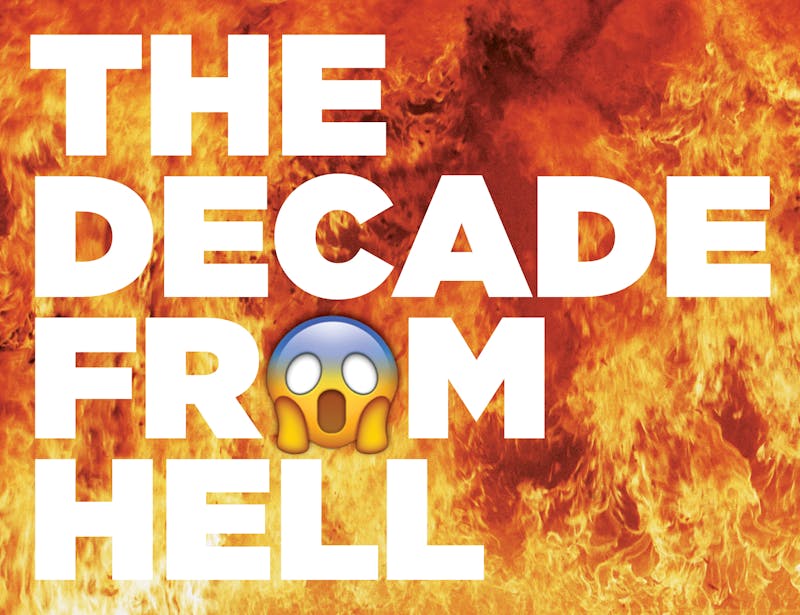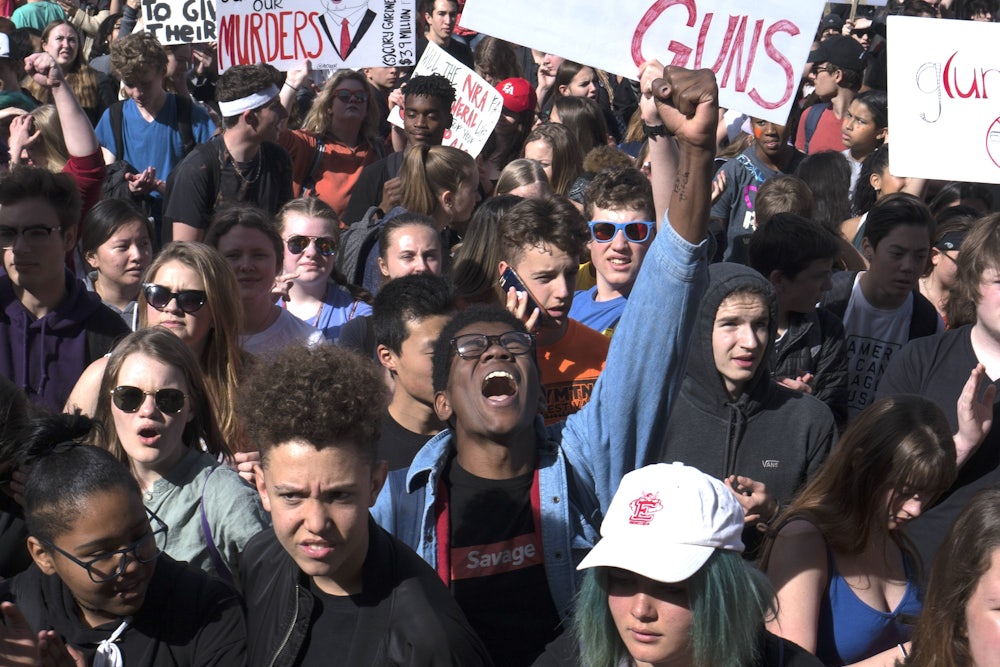Welcome to the Decade From Hell, our look back at an arbitrary 10-year period that began with a great outpouring of hope and ended in a cavalcade of despair.

Almost immediately after one of the decade’s bleakest moments—the day President Donald Trump issued an executive order barring travelers from several predominantly Muslim countries from entering the United States in January 2017—airports across the nation were swarmed by activists, politicians, celebrities, and ordinary people determined to voice their outrage and do whatever they could to support those who had found themselves swiftly detained. They were joined by legions of attorneys from organizations like the American Civil Liberties Union, who volunteered to counsel and represent detainees and their families on the spot.
Andre Segura, an ACLU lawyer who spent much of the weekend after the order at New York’s Kennedy International Airport, told The New York Times that the demonstrations had been unlike anything he’d seen before. “The dynamic between what was happening inside the terminal with all the attorneys, and outside with massive protests and people holding signs—I’ve never experienced anything like that,” he said.
Those, like Segura, who have taken to protest and direct action in the Trump era have not just taken a stand against this administration. They have also fought against a cynicism about protest movements that has pervaded political discourse for years. It’s said routinely that we live in an age of slacktivism—that gathering large crowds in support of a cause has been made both simple and ineffectual by social media. Protests have never been easier to organize, and, as a consequence, have never been more unfocused, disorganized, and prone to failure. “Before the Internet, the tedious work of organizing that was required to circumvent censorship or to organize a protest also helped build infrastructure for decision making and strategies for sustaining momentum,” University of North Carolina sociologist and Times contributor Zeynep Tufekci wrote in 2014. “Now movements can rush past that step, often to their own detriment.”
But any straightforward review of the decade’s major protest movements in America should paint a different picture: The 2010s were the most wildly successful decade for mass protest since the 1960s—an era of astonishing victories that suggest direct action today not only works but may also be among the most effective vehicles for change moving forward, as our nation’s political institutions continue to decline.
Consider the women’s marches on the day after Trump’s inauguration—the largest coordinated protests in American history, which brought well over three million people into the streets of cities nationwide to make their voices heard on issues from reproductive freedom to Russia’s interference in the 2016 election. The marches’ skeptics leveled a variety of criticisms against participants and organizers. The focus on women, it was predicted, would constrain the size of the marches by dissuading men from attending. Their lack of a singular objective, some argued, would deprive them of meaning and fail to encourage sustained political action from demonstrators. The pussy hats were mocked as silly. A critical piece for The Week on January 2, weeks before the marches occurred, was titled “Why the Women’s March on Washington has already failed.”
“Demonstrations serve a useful function in a democracy—but only when they have clarity of purpose,” the columnist Shikha Dalmia wrote. “That is not the case with the Women’s March on Washington, which will be held in Washington, D.C., the day after Donald Trump is sworn in. Instead the march is shaping up to be a feel-good exercise in search of a cause.” But the 2017 women’s marches were followed the next year by a series of successor marches with well over a million participants—the second-largest coordinated protests in American history—as well as a historic wave election for the Democratic Party fueled in part by organizing and trainings from progressive groups like Emily’s List, which either sponsored or were bolstered by the marches.
Cynicism about protest found a target early in this decade in Occupy Wall Street, which brought activists in cities across America and around the world together in the wake of the financial crisis to protest the malfeasance of the big banks, the failure of governments to hold them accountable, and rising inequality under capitalism. Within a year of New York protesters being ousted from Zuccotti Park by city police, commentators were ready to call the movement a failure. In a 2012 piece, the Times’ Andrew Ross Sorkin predicted that Occupy would “be an asterisk in the history books, if it gets a mention at all” and that demonstrators, beyond failing to meaningfully change financial policy, had additionally failed to inspire progress “even on the issues of economic inequality and upward mobility.”
“By the second or third time I went down to Zuccotti Park, it became clear to me that Occupy Wall Street, which began with a small band of passionate intellectuals, had been hijacked by misfits and vagabonds looking for food and shelter,” he wrote. “Given the way the organization—if it can be called that—was purposely open to taking all comers, the assembly lost its sense of purpose as various intramural squabbles emerged about the group’s end game.”
Yet by forging social connections and providing experience to progressive activists and organizations, Occupy successfully laid the groundwork for more targeted protest campaigns that followed on issues like housing inequality and student debt. Eight years later, it’s difficult to imagine our current discourse on inequality—or the present centrality of inequality as a policy issue to begin with—without the framing and language that Occupy popularized. When historians set about explaining how it came to be that progressive rhetoric, and even the design of redistributive policies, came to focus so heavily on the divide between the top 1 percent and the bottom 99 percent of income earners by the decade’s end, the protesters who mainstreamed these ideas will obviously merit well more than a footnote.
One of the most successful post-Occupy movements against inequality has been Fight for 15, a campaign for $15 minimum wages, which began a year after Occupy, with fast-food worker walkouts in New York City. In the years since, Fight for 15’s demonstrations, sit-ins, and labor actions have won state and local minimum wage increases that amount to a $68 billion raise for 22 million workers, according to the National Employment Law Project. A $15 federal minimum has also become part of the Democratic Party’s national platform, and a bill hiking the wage to $15 was passed by the Democratic House this summer.
The strikes and walkouts in the fast food industry and by other low-wage workers have been part of the decade’s wider resurgence in conventional labor action. Nearly half a million people participated in work stoppages in 2018, the largest number since 1986. Most who walked off the job were teachers participating in last year’s massive strikes for better pay and better schools—actions inspired in large part by the success of the Chicago Teachers’ Union’s strike in 2012. In the years since, strikers have managed to win pay increases and additional school funding, as well as shifting the Democratic Party away from the reform paradigm that has shaped education policy for a generation.
Democrats, and the country as a whole, have also moved left on criminal justice policy, thanks largely to the activism of Black Lives Matter and the conversations that movement has inspired about race, policing, and mass incarceration. The 2014 demonstrations in Ferguson and the police response they engendered particularly captivated the nation. Despite warnings from commentators who insisted that looting, vandalism, and the perception of racial antagonism could hobble the efforts of peaceful organizers, protesters managed to change white racial attitudes so rapidly and dramatically that white liberals are now to the left of racial minorities themselves on a number of racial issues. According to Pew, the number of Americans, of all races, who believe the country “needs to continue making changes to give blacks equal rights with whites” jumped 13 points between the months just before Ferguson in 2014 and the months just afterward in 2015—from a 46 percent minority to a 59 percent majority. That swing in public opinion has been reflected in the success of new criminal justice and police accountability efforts at the local, state, and federal levels.
Direct action can also be credited with a shift in the politics of gun control. The shooting at Parkland, Florida’s Marjory Stoneman Douglas High School in February 2018 could easily have passed into memory like many of the mass shootings that preceded it—with a wave of outrage too fleeting to meaningfully dent the status quo on gun policy. But the Parkland teens used the narrow window of opportunity offered by media attention to build a protest movement that culminated in a national school walkout and the March for Our Lives, the latter amounting to the third-largest coordinated protest in American history, with participants rallying in 90 percent of the nation’s congressional districts. By extending the half-life of post-shooting discourse, the March for Our Lives helped make gun control a key issue in the suburban swing districts the Democrats flipped in the 2018 midterms and also inspired legislative action: The number of new gun control laws passed at the state level more than tripled from 2017 to 2018, surpassing the number of laws passed to weaken existing gun laws for the first time in six years.
The Parkland teens’ national walkout inspired 16-year-old Swedish climate activist Greta Thunberg to organize her own school strikes in protest of climate inaction; these drew millions of participants around the world. But it was a sit-in by just over 200 activists that reshaped American climate politics last year. Since the Sunrise Movement and Congresswoman Alexandria Ocasio-Cortez briefly occupied Speaker Nancy Pelosi’s D.C. office in November 2018 to demand the Democratic Party commit itself to a Green New Deal, the proposal and the climate crisis more broadly have been placed at the center of the Democratic policy conversation.
Despite these progressive victories—and others where protest played a role, from the Obama administration’s rejection of the Keystone XL Pipeline to the removal of confederate flags and monuments nationwide—it should be said that the most successful protest movement of the decade was likely a movement on the right. As the Tea Party faded from headlines, much was made of the movement’s failure to consistently secure electoral victories. Some pundits additionally pointed to major donors and establishment Republicans backing significant organizations in the movement like FreedomWorks and Tea Party Express as evidence that the Tea Party was nothing more than an astroturfed mirage without real and meaningful grassroots support.
Yet Tea Party demonstrations at congressional town halls and elsewhere not only captured the narrative around the major legislative effort of the last Democratic administration, they also bolstered conservative political participation and created a new organizational infrastructure on the right. A 2011 study by economists at Harvard and Stockholm University estimated that each attendee at 2009’s Tax Day marches produced between seven and 14 additional Republican votes in the 2010 elections. The Tea Party also exerted enough pressure on the Republican Party to pull it toward the reactionary and conspiratorial populism that both defines it today and made the Trump presidency possible.
The Decade from Hell has put us further down a path toward both national and planetary ruin. It has, however, also offered numerous stories that can guide us in a new direction—stories about the power of ordinary people coming together to present the moral cases for change and demand that the powerful act on these cases. There is no substitute, even in this digital age, for direct action. The best remedy for business as usual remains making business as usual impossible.
